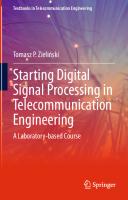The Economics of Telecommunication Services: An Engineering Perspective 9783030338640, 9783030338657
This textbook characterizes the economics of telecommunication services from an engineering perspective. The authors bri
342 94 3MB
English Pages 192 [196] Year 2020
Table of contents :
Preface
Acknowledgements
Contents
About the Authors
1 Characteristics and Characterization of Information Networks
1.1 What Is Information?
1.2 Modalities of Information
1.3 Analog and Digital Information
1.4 Networks: The Externality Factor
1.4.1 Network Mergers
1.4.2 Motivation for Merging Networks
1.5 Merger of Heterogeneous Networks
1.6 Illustrative Example
Problems
References
2 Drivers of the Telecommunication Industry
2.1 Bandwidth
2.2 Processing Power
2.3 Composition of the Telecommunication Industry
2.4 Telecommunication Services Utility and Demand
2.5 Price Elasticity of Demand
2.6 Cross Elasticity of Demand
2.7 Price and Cross Elasticity of Demand for Telecommunication Services
2.8 Summary
Problems
References
3 Graph Theoretic Characterization of Communication Networks
3.1 Networks and Graph Theory
3.2 Graphs of Some Well-Known Networks
3.3 Networks of Information
3.4 The Legacy PSTN: A Graphical Representation
3.5 Graphical Representation of Networks
3.6 Degree Distribution and Clustering Property of Networks
3.7 Betweenness and Closeness of Network
3.8 Diameter, Radius of a Node, and Center of a Graph
3.9 Entropy of a Network
3.10 Evolution of Networks
3.11 Models of Contemporary Networks: Random Networks
3.11.1 Random Networks
3.11.2 Properties of Random Networks
3.12 Summary
Problems
References
4 Small World and Scale-Free Networks
4.1 Small World Networks
4.2 Scale-Free Networks
4.3 Summary
Problems
References
5 Characterization of Telecommunication Traffic
5.1 Common User Networks
5.2 Circuit and Packet Switching
5.3 Performance Parameters of Networks
5.4 Characterization of Traffic
5.5 Selection of Transmission Medium
5.6 Interdependence of Performance Parameters
5.7 Forward Error Correction Scheme
5.8 Backward Error Correction Scheme
5.9 The Impact of Window Size on Throughput
5.10 Summary
Problems
References
6 Bandwidth and Throughput of Networks: Circuit Switched Networks
6.1 Circuit and Packet Switched Traffic
6.2 Erlang B Traffic Characterization
6.3 Summary
Problems
References
7 Bandwidth and Throughput of Networks: Packet Switched Networks
7.1 Delay in Packet Switched Networks
7.2 Analytical Model
7.3 Multi-hop Packet Switched Networks
7.4 Impact of Multi-Hopping on Throughput
7.5 Summary
Problems
References
8 Pricing of Telecommunication Services
8.1 The Role of Pricing in Network Services
8.2 Traditional Methods of Pricing Telecommunication Services
8.3 Characteristics of Communication Services
8.4 Other Considerations in Pricing Network Services
8.5 Related Work on Pricing Network Services
8.5.1 Pricing for Regulated Telecommunication Services
8.5.2 Pricing Internet Services
8.5.3 Recent Literature on Pricing Multi-Service Communication Networks
8.6 Summary
Problems
References
9 Pricing of Circuit Switched Services
9.1 Resource Consumption Based Pricing for Circuit Switched Networks
9.2 Pricing for Multi-hop Traffic
9.2.1 Pricing for a Single-hop Traffic
9.2.2 Pricing for Two-hop Traffic
9.2.3 Pricing for Multi-hop Traffic
9.3 Summary
9.4 Problems
References
10 Pricing of Packet Switched Services
10.1 Pricing Based on Bounded Delays
10.1.1 Pricing for Single-hop Networks
10.1.2 Pricing for Two-hop and Multi-hop Networks
10.2 Pricing Based on Bounded Jitter
10.2.1 Pricing for Single-hop Networks
10.2.2 Pricing for Multi-hop Networks
10.3 Summary
Problems
References
11 Regulation
11.1 Need for Regulation
11.2 Forms of Regulatory Safeguards
11.2.1 Rate of Return Regulation
11.2.2 Price Cap Regulation
11.3 Emerging Regulatory Apparatus in the USA
11.4 A Constant Revenue Model for Blocked and Lost Networks
11.4.1 Mathematical Construct
11.5 Summary
Problems
References
12 Net Neutrality
12.1 Introduction
12.2 Stakeholders in the Broadband Access Era
12.3 Net Neutrality
12.4 The Sustainability of Net Neutrality
12.5 Net Neutrality vs. Transportation Neutrality
12.6 A Constant Revenue Model for Net Neutrality
12.7 Summary
Problems
References
13 Game Theory and Its Applications to Communication Networks
13.1 A Brief Introduction to Game Theory
13.1.1 Non-cooperative Games
13.1.2 Cooperative Games
13.2 Game Theory in Communication Networks
13.3 Summary
Problems
References
14 Multi-Service Network Models
14.1 Introduction
14.2 Users and Network Provider Models
14.2.1 Utility Functions for Users
14.2.2 Utility Functions for the Network Provider
14.3 Network Model
14.4 Pricing Model
14.5 Summary
Problems
References
15 Subsidy-Free Prices in Priority-Based Networks
15.1 Introduction
15.2 The Model
15.3 Waiting Cost Sharing Using the Shapley Value
15.4 Axiomatic Characterization of the Shapley Value
15.5 An Illustrative Example
15.6 Summary
Problems
References
16 A Constant Revenue Model for Net Neutrality
16.1 Background
16.2 The Model
16.3 Inter-user Compensations Scheme
16.4 An Example and Further Discussion
16.5 Summary
Problems
References
17 A Two-step Quality of Service Provisioning in Multi-Class Networks
17.1 The Model
17.2 Game Theoretic Framework
17.3 Inter-class Resource Allocation
17.4 An Illustrative Example
17.5 Summary
Problems
References
18 Network of the Future
18.1 Need for Advanced Level of Control
18.2 Pricing of Network Services
18.3 The Network as a Surrogate for Privacy and Security
18.3.1 Network-Based Security
18.4 Summary
Appendix AShow that ∂lnn∂n = 1n
Appendix B: Merger of Heterogeneous Networks
References
Bibliography
Index
Preface
Acknowledgements
Contents
About the Authors
1 Characteristics and Characterization of Information Networks
1.1 What Is Information?
1.2 Modalities of Information
1.3 Analog and Digital Information
1.4 Networks: The Externality Factor
1.4.1 Network Mergers
1.4.2 Motivation for Merging Networks
1.5 Merger of Heterogeneous Networks
1.6 Illustrative Example
Problems
References
2 Drivers of the Telecommunication Industry
2.1 Bandwidth
2.2 Processing Power
2.3 Composition of the Telecommunication Industry
2.4 Telecommunication Services Utility and Demand
2.5 Price Elasticity of Demand
2.6 Cross Elasticity of Demand
2.7 Price and Cross Elasticity of Demand for Telecommunication Services
2.8 Summary
Problems
References
3 Graph Theoretic Characterization of Communication Networks
3.1 Networks and Graph Theory
3.2 Graphs of Some Well-Known Networks
3.3 Networks of Information
3.4 The Legacy PSTN: A Graphical Representation
3.5 Graphical Representation of Networks
3.6 Degree Distribution and Clustering Property of Networks
3.7 Betweenness and Closeness of Network
3.8 Diameter, Radius of a Node, and Center of a Graph
3.9 Entropy of a Network
3.10 Evolution of Networks
3.11 Models of Contemporary Networks: Random Networks
3.11.1 Random Networks
3.11.2 Properties of Random Networks
3.12 Summary
Problems
References
4 Small World and Scale-Free Networks
4.1 Small World Networks
4.2 Scale-Free Networks
4.3 Summary
Problems
References
5 Characterization of Telecommunication Traffic
5.1 Common User Networks
5.2 Circuit and Packet Switching
5.3 Performance Parameters of Networks
5.4 Characterization of Traffic
5.5 Selection of Transmission Medium
5.6 Interdependence of Performance Parameters
5.7 Forward Error Correction Scheme
5.8 Backward Error Correction Scheme
5.9 The Impact of Window Size on Throughput
5.10 Summary
Problems
References
6 Bandwidth and Throughput of Networks: Circuit Switched Networks
6.1 Circuit and Packet Switched Traffic
6.2 Erlang B Traffic Characterization
6.3 Summary
Problems
References
7 Bandwidth and Throughput of Networks: Packet Switched Networks
7.1 Delay in Packet Switched Networks
7.2 Analytical Model
7.3 Multi-hop Packet Switched Networks
7.4 Impact of Multi-Hopping on Throughput
7.5 Summary
Problems
References
8 Pricing of Telecommunication Services
8.1 The Role of Pricing in Network Services
8.2 Traditional Methods of Pricing Telecommunication Services
8.3 Characteristics of Communication Services
8.4 Other Considerations in Pricing Network Services
8.5 Related Work on Pricing Network Services
8.5.1 Pricing for Regulated Telecommunication Services
8.5.2 Pricing Internet Services
8.5.3 Recent Literature on Pricing Multi-Service Communication Networks
8.6 Summary
Problems
References
9 Pricing of Circuit Switched Services
9.1 Resource Consumption Based Pricing for Circuit Switched Networks
9.2 Pricing for Multi-hop Traffic
9.2.1 Pricing for a Single-hop Traffic
9.2.2 Pricing for Two-hop Traffic
9.2.3 Pricing for Multi-hop Traffic
9.3 Summary
9.4 Problems
References
10 Pricing of Packet Switched Services
10.1 Pricing Based on Bounded Delays
10.1.1 Pricing for Single-hop Networks
10.1.2 Pricing for Two-hop and Multi-hop Networks
10.2 Pricing Based on Bounded Jitter
10.2.1 Pricing for Single-hop Networks
10.2.2 Pricing for Multi-hop Networks
10.3 Summary
Problems
References
11 Regulation
11.1 Need for Regulation
11.2 Forms of Regulatory Safeguards
11.2.1 Rate of Return Regulation
11.2.2 Price Cap Regulation
11.3 Emerging Regulatory Apparatus in the USA
11.4 A Constant Revenue Model for Blocked and Lost Networks
11.4.1 Mathematical Construct
11.5 Summary
Problems
References
12 Net Neutrality
12.1 Introduction
12.2 Stakeholders in the Broadband Access Era
12.3 Net Neutrality
12.4 The Sustainability of Net Neutrality
12.5 Net Neutrality vs. Transportation Neutrality
12.6 A Constant Revenue Model for Net Neutrality
12.7 Summary
Problems
References
13 Game Theory and Its Applications to Communication Networks
13.1 A Brief Introduction to Game Theory
13.1.1 Non-cooperative Games
13.1.2 Cooperative Games
13.2 Game Theory in Communication Networks
13.3 Summary
Problems
References
14 Multi-Service Network Models
14.1 Introduction
14.2 Users and Network Provider Models
14.2.1 Utility Functions for Users
14.2.2 Utility Functions for the Network Provider
14.3 Network Model
14.4 Pricing Model
14.5 Summary
Problems
References
15 Subsidy-Free Prices in Priority-Based Networks
15.1 Introduction
15.2 The Model
15.3 Waiting Cost Sharing Using the Shapley Value
15.4 Axiomatic Characterization of the Shapley Value
15.5 An Illustrative Example
15.6 Summary
Problems
References
16 A Constant Revenue Model for Net Neutrality
16.1 Background
16.2 The Model
16.3 Inter-user Compensations Scheme
16.4 An Example and Further Discussion
16.5 Summary
Problems
References
17 A Two-step Quality of Service Provisioning in Multi-Class Networks
17.1 The Model
17.2 Game Theoretic Framework
17.3 Inter-class Resource Allocation
17.4 An Illustrative Example
17.5 Summary
Problems
References
18 Network of the Future
18.1 Need for Advanced Level of Control
18.2 Pricing of Network Services
18.3 The Network as a Surrogate for Privacy and Security
18.3.1 Network-Based Security
18.4 Summary
Appendix AShow that ∂lnn∂n = 1n
Appendix B: Merger of Heterogeneous Networks
References
Bibliography
Index

![The Economics of Telecommunication Services: An Engineering Perspective [1st ed.]
9783030338640, 9783030338657](https://ebin.pub/img/200x200/the-economics-of-telecommunication-services-an-engineering-perspective-1st-ed-9783030338640-9783030338657.jpg)



![Defense Economics: An Institutional Perspective [1st ed. 2021]
3030738140, 9783030738143](https://ebin.pub/img/200x200/defense-economics-an-institutional-perspective-1st-ed-2021-3030738140-9783030738143.jpg)



![Distillation Control: An Engineering Perspective [1 ed.]
0470381949, 9780470381946](https://ebin.pub/img/200x200/distillation-control-an-engineering-perspective-1nbsped-0470381949-9780470381946.jpg)
![Cloud Technologies and Services: Theoretical Concepts and Practical Applications (Textbooks in Telecommunication Engineering) [1st ed. 2024]
3031336682, 9783031336683](https://ebin.pub/img/200x200/cloud-technologies-and-services-theoretical-concepts-and-practical-applications-textbooks-in-telecommunication-engineering-1st-ed-2024-3031336682-9783031336683.jpg)